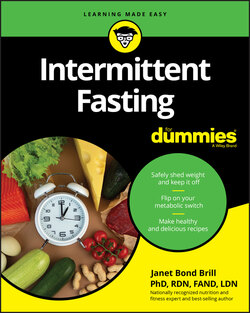Читать книгу Intermittent Fasting For Dummies - Janet Bond Brill - Страница 44
Studying Calories 101
ОглавлениеWhen you cut down on your intake of one macronutrient (whether it’s carbs or fat — both popular fad diet strategies), or you restrict yourself from eating for 16 hours in a particular day (such as the 16:8 intermittent fasting plan), your total calories consumed for that day will be lower than what you would have eaten on a typical day in your pre-fasting life. This action creates a calorie deficit — the all-important basis for weight loss.
A calorie isn’t something tangible, like something you pick up when you hold a chocolate chip cookie. A calorie is instead simply a measurement also known as a unit of energy. Think of an inch as a measurement of length and a calorie as a measurement of energy.
Science has two forms of calories:
Calorie with a small c as in calorie: The scientific description of a calorie is the amount of heat needed to raise the temperature of one gram of water by one degree Celsius. This calorie isn’t the same one most people think of when discussing food, so I don’t discuss it any further.
Calorie with a big C as in Calorie: In nutritionist language it’s called a kilocalorie or kcal for short. Nutritionists use these terms to refer to calories in food or to calories burned during exercise. The scientific definition of kilocalories is the amount of heat needed to raise the temperature of 1 kilogram of water by 1 degree Celsius. You use this calorie when reading the food labels in the supermarket. Note: Books about weight loss and weight gain refer to this type of calorie.
